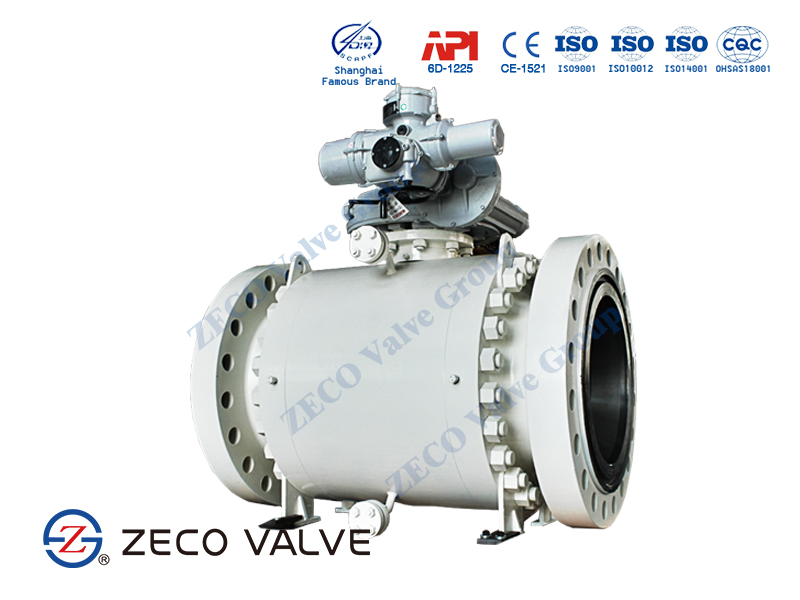Electric Ball Valve, Motorized Ball Valve and Electronic Ball Valve are actually the same kind of ball valve, just with different names.
What is an Electric Ball Valve? Motorized Ball Valve? Electronic Ball Valve?
The ball valve itself is not electric. When someone says “electric ball valve” or “motorized ball valve” or “electronic ball valve”they mean a regular ball valve with an electric actuator. Valves built for automating typically have an industry standard (ISO 5211) 4-bolt mounting pad that the actuator mounts to.

How do Electric Ball Valves work?
Electric actuated valves use electric actuators to drive them open and closed. Electric valve actuators typically convert high speed low torque output motors into low speed high rotary torque output that drives the valve via a gearbox.
Electric ball valves use part-turn rotary electric actuators because the working angle of a ball valve is typically 90 degrees, and are very popular as electric actuated ball valves can offer a cost effective solution for valve automation.
Optional Electric Actuators for Electric Ball Valves
ZECOAV Quarter Turn Actuator is a high-quality electric actuator to operate quarter turn valves such as ball valves. The following parameters are available for reference.
- Quarter turn Actuator AV01 – AV06 can be combined with lever if it is required.
- Quarter turn Actuator AV01 – AV06 torque range is from 125Nm to 2000Nm (90ft-lbf to 1475ft-lbf)
- Voltage Supply: 220Vac ~ 460Vac, 50Hz/60Hz, single or three phase.
- Enclosure Protection: IP68, Double-seated structure.
- Isolation: Class F, Class H (optional)
Optional Function:
- Modulating I/O signal 4-20mA
- Explosion Proof(ATEX,CUTR)
- Fieldbus System: Modbus, Profibus, etc.
What are Motorized Ball Valves used for?
- Vacuum & high pressure applications
- Gaseous, liquid, gelatinous or highly viscous media
- High cycle applications
- Precise mixing/dispensing
- Process control applications
- Ink & paint dispensing
- Industrial compressors
Features & Benefits of Electric Ball Valves
One of the benefits is the valve’s ability to continue working at a high flow rate, despite a pressure drop. Since they don’t have a diaphragm they have a greater Cv value, or flow compared to the same size solenoid valve.
They are, like solenoid valves, another affordable valve type that is fairly easy to install. They are easily integrated into automation systems through multiple devices like PCs and even Raspberry Pis. The total operating cost of a motorized ball valve is also lower than solenoid valves because they don’t require continuous power to hold position. This feature is also beneficial to users since the ball valve is not prone to burning out like solenoids.
Main Differences Between Electric Ball Valves and Solenoid Valves
- I. Leakage
Electric Ball Valve or electric actuated ball valve is an electrically operated ball valve. Its action principle is angular stroke, double-sided sealing, good sealing performance. It is not easy to leak. The action principle of solenoid valve is straight stroke, diaphragm or pilot type. The purity requirement of sealing surface is very high, and impurities in medium can easily cause leakage.
- II. Installation Location Requirements
Electric ball valves have no requirement for installation angle. The solenoid valve is a straight-stroke action principle, and its sealing needs to be realized by the action of gravity of the valve core and the electromagnet. Therefore, the solenoid valve can only be installed horizontally, and other angle installation will cause the leakage of the solenoid valve.
- III. Service life
When the switch of the electric ball valve actuator is in place, it will be cut off by the internal micro-switch, and it has the function of position maintenance. It only needs to be powered when the switch is in place, and the motor will not be charged after the switch is in place. Its service life is longer than that of the solenoid valve, and its performance is stable. The operation of opening and closing of solenoid valves depend on the coil electrification. The coil needs to be electrified all the time when the working position is maintained (such as normally closed solenoid valves need to be opened for a long time). The coil will be heated when the coil is electrified for a long time, which will easily cause the coil to burn out. This kind of fault is quite common.
- IV. Protection Level
The electric ball valve actuator is protected by the shell, the protection level IP65/IP67, dust and moisture can hardly erode the internal of the actuator, and its performance is stable. The solenoid valve has simple structure, low protection level. It is easily affected by dust, air and temperature.
- V. Cost differentials
Electric ball valves are atmospheric pressure for 1.6 MPa. The ball valves can achieve 13 MPa, and the cost is not much different from 1.6 MPa. Especially, the high-pressure cost has great advantages over solenoid valves. For solenoid valves, more than 1.0 MPa is considered to be medium and high pressure, high-pressure solenoid valves are generally expensive.
- VI. Functional differences
The electric actuator is equipped with manual operation device, which can operate and control the valve opening/closing manually without the need to install by-pass standby. Generally, solenoid valves have no manual operation function, so by-pass manual valves need to be installed in pipelines.












